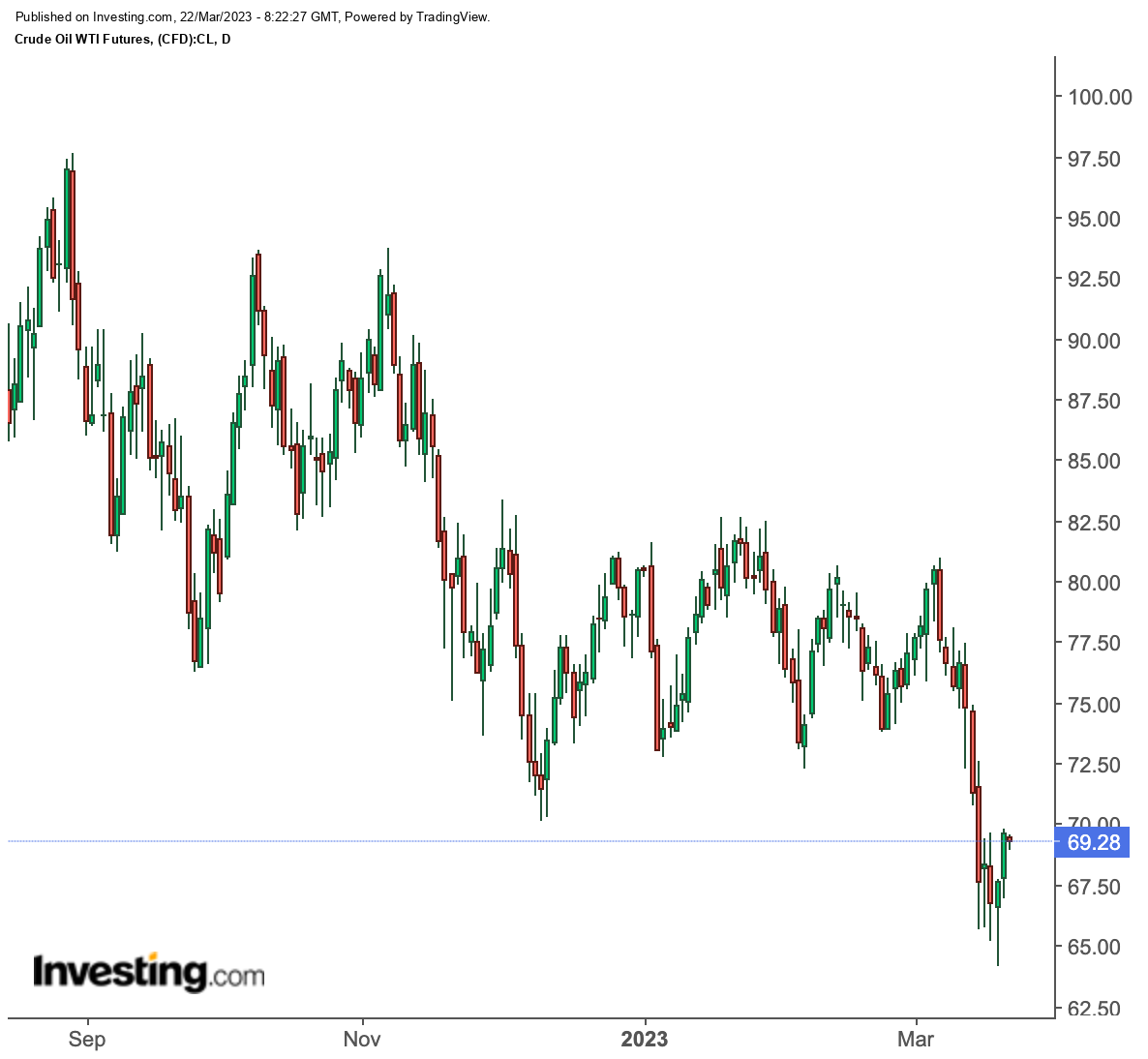- Crude prices up 4% in two days after last week’s 13% slide
- Potentially hawkish Fed could disrupt oil’s continued rebound
- Crude bulls thus hoping OPEC+ will “fix” market in run-to its April 3 meet
From California to Zurich to Washington: The oil trade’s focus has traversed three datelines at a dizzying pace over the past ten days as attention moves from the banking crisis to the Federal Reserve decision on rates today.
It will probably take another ten days, and a virtual dateline before the longs in crude can feel settled and in control of the market again.
That will be on or after the OPEC+ virtual meeting on April 3 that allows the world’s oil producers to reintroduce the fear of tight supply into the market’s narrative — to counter the liquidity fear spawned by the banking crisis and any recession fear exacerbated by Fed Chair Jerome Powell’s outlook on inflation and future rates.
Bloomberg oil analyst Grant Smith — blogging Monday from Lake Geneva where commodities merchants at a Financial Times’ retreat were assessing the demise of Credit Suisse — said ructions from the California-to-Zurich banking crisis would transition to the Fed decision and outlook on rates. He wrote:
“Trading executives do acknowledge that banking contagion poses a risk for any commodities bull run. And the next key test for that, they concede, lies not on the shores of a Swiss lake, but thousands of miles away, with Wednesday’s decision from the Federal Reserve.”
US West Texas Intermediate had recovered in the past two sessions 4% of the 13% it lost last week, during what turned out to be oil’s worst week since the breakout of the coronavirus pandemic three years ago. UK Brent pulled back 3% between Monday and Tuesday, also from a 13% slump last week.
Some six hours before the start of Wednesday’s New York trading session, WTI was within striking distance of making a return to the key $70-per-barrel level after tumbling on Monday to $64.12, its lowest since December 2021. Brent hovered at just under $75 after making a 15-month low of $70.12 just two days earlier.

The rebound in the past 48 hours gave oil bulls a jolt in confidence that the worst from the banking crisis might be over. Or that at least fears of contagion from it had paused.
Rumblings about runaway Chinese demand for oil — drowned out during the past bear week for crude — popped up again in Smith’s Bloomberg commentary, with Trafigura Group quoted saying that China was “booming again, with restaurants packed and domestic travel roaring above pre-pandemic levels, even if Western investors don’t believe it.”
“The further you are away from China, the less likely you are to believe in the China recovery,” Trafigura chief economist Saad Rahim added.
Also back in play were cautions that the recent market slump could lead to tighter oil production.
“The break in the oil prices is going to cause a reduction in investment in oil production and that is going to make the long-term structural shortage in the oil market worse as we move forward,” said Phil Flynn, analyst at Chicago’s PRICE Futures Group, and one of the loudest voices on the long-oil side.
To be sure, Flynn said it wasn’t just him saying that.
“The CEO of Trafigura Jeremy Weir is warning that current oil prices are not encouraging production. He also believes that there is not going to be too much downside for oil from this level,” Flynn added in a commentary issued Tuesday.
The Fed uncertainty, however, hangs heavy over the oil market.
The central bank is expected to approve another 25-basis-point hike, bringing U.S. interest rates to a peak of 5%. While that seems baked into the cake, what’s not is what Chairman Jerome Powell will say.
Powell could say the banking crisis has given the Fed some rethink over rates, which would be huge for the risk-on crowd and could send crude rallying another 3% or even 5%. Wall Street has been trying to pin the collapse of at least two US banks, Silicon Valley and Signature, and the near-insolvency at a third, called First Republic (NYSE:FRC), on the Fed’s so-called excessive rate hikes — not reckless risk-taking by the executives of the banks that went under. The aim is simple: Get the Fed to stop rate hikes altogether so that the S&P 500 can rise another 500 points.
But the Fed could also go the other way — and this is what many are betting — with Powell advocating a continuation in monetary tightening until inflation returns to its target of 2% per year from February’s annual growth of 6%. Such hawkish talk could spell doom for oil and other risk assets just rebounding from last week’s battering in confidence.
TD Cowen zeroed in on the odds of resolute inflation-battling Fed in an equity markets note issued on Tuesday:
“In previous episodes of sudden financial distress outside the Great Financial Crisis, the Fed often responded with easing in its policy stance … However, the current circumstance is more unique, as the Fed has a stubborn inflation problem at hand next to financial market instability,” the unit of TD Securities said in the note.
Add to that the likelihood of the US Energy Information Administration reporting another bearish weekly crude inventory number in data due today, and WTI could roll back much of the gains of the past two days.
Oil: Guilty Until Proven Innocent?
Fawad Razaqzada, analyst at London’s StoneX, is among those demanding more proof that this week’s rebound in oil could be sticky.
“Has oil bottomed? Until last week’s breakdown, oil prices had been stuck inside a corridor for a long time. So, this two-day recovery should not be mistaken for a market bottom. Guilty until proven otherwise, is how I would approach crude prices. Oil prices need to show us clear evidence that it has formed a low.”
Razaqzada also pointed out that crude prices had been trending lower for months, their breakdown last week from a multi-week consolidation pattern suggests there may be more downside potential in oil prices. He adds:
“The impact of very high levels of inflation over the past couple of years has been hurting consumption, while the significant interest rate tightening by central banks have further reduced consumer and business buying power. The full impact of the past tightening has yet to be felt fully on the global economy. There’s hope that with China recently re-opening its economy, demand would accelerate.”
On the supply side, Razaqzada said non-OPEC production, led by Russia, is continuing to rise, absorbing the pent-up demand from China’s re-opening. He noted that the International Energy Agency, or IEA, recently forecast that the global oil supply will “comfortably” exceed demand in the first half of this year — after initially projecting record demand from China for all of 2023.
“For now, news that Russia has decided to keep its oil production at a reduced level through June and calmer market conditions has helped to keep prices in the positive territory,” Razaqzada said. “The crude oil outlook remains murky, despite the ongoing OPEC+ restrictions … as non-OPEC supply rises.”
Therein lies the question of what OPEC+ — which comprises the Saudi-led 13-member Organization of the Petroleum Exporting Countries banded with 10 independent oil producers steered by Russia — can do to push the oil market back.
I’ll be honest: OPEC on its own — i.e., led by the solitary power of the Saudis — can do quite a bit. With OPEC+ — i.e., Russia in tow — the combined organization can do a lot more. That was the basis anyway for Riyadh having courted Moscow back in 2015 for an alliance.
Except for a brief and very public row between the two at the height of the COVID-19 breakout in 2020, the Saudi-Russian joint stewardship of OPEC+ has been admirable in holding up the market — mostly with half-truths about production and veiled threats on output squeezes seldom carried out over the past half year.
Given that a third of global supply is already at risk from the sanctions imposed on Russia over Ukraine, OPEC+ knows that the fear of undersupply is greater to the oil market than concerns of a glut.
Thus, the careful dropping of words like “the market needs to be balanced” is often enough to create a premium of between $5 to $10 per barrel anytime from a week before an OPEC meeting to one after it. That $10 would essentially cover all that crude prices lost over the past week.
For the record, since November, the alliance is supposed to be practicing a daily output cut of two million barrels.
Yet, overproduction is reported commonly, with the refrain being that the market is still balanced.
Said John Kilduff, partner at New York energy hedge fund Again Capital:
“Data will show that OPEC+ has done bunk in many months with the so-called production cut of 2.0 million barrels. But the market keeps buying the BS.”
After crude prices hit 15-month lows last week, Iraq's Prime Minister Mohammed Shia' Al Sudani and OPEC Secretary General Haitham al-Ghais stressed the need to coordinate among oil-exporting nations to ensure prices do not fluctuate and impact both exporter and consumer countries. Interestingly, OPEC+ never sees the need to coordinate or “balance” the market when prices are rising.
We’ll see in the week ahead and the week after April 3 what OPEC+ can — and will — do to “fix” the market.
***
Disclaimer: Barani Krishnan uses a range of views outside his own to bring diversity to his analysis of any market. For neutrality, he sometimes presents contrarian views and market variables. He does not hold positions in the commodities and securities he writes about.

